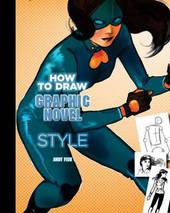
|
How to Draw Graphic Novel Style
Spiral bound
Main Details
| Title |
How to Draw Graphic Novel Style
|
| Authors and Contributors |
By (author) Andy Fish
|
| Physical Properties |
| Format:Spiral bound | | Pages:224 | | Dimensions(mm): Height 195,Width 145 |
|
| Category/Genre | Painting and art manuals |
|---|
| ISBN/Barcode |
9781844486298
|
| Classifications | Dewey:741.51 |
|---|
| Audience | |
|---|
| Illustrations |
200 Illustrations, color
|
|
Publishing Details |
| Publisher |
Search Press Ltd
|
| Imprint |
Search Press Ltd
|
| Publication Date |
26 October 2010 |
| Publication Country |
United Kingdom
|
Description
Graphic novels are a development of comic books, and much like other literary forms, it is difficult to create a general description of them. Graphic novels can cover a wide variety of subjects and genres, including crime, biography, slice-of-life, drama, fiction, sci-fi, horror and even superheroes. The artwork itself is somewhat more advanced than a regular comic book style, and a graphic novel uses a more sophisticated method of combining words and pictures to convey a story. The book itself is divided into two parts, beginning with a thorough exploration of techniques that include tools and equipment; graphic novel styles, characters and genres; the art of storytelling; special effects and creating words. The second part of the book consists of projects, covering character design, showing emotion and planning a story. At the end of the book there is a useful glossary, further reading list and index.
Author Biography
Andy Fish studied art at The School of Visual Arts in New York City as well as Rhode Island School of Design, has has also attended Clark University School at the Worcester Art Museum and Worcester State College. Andy has a diverse commercial art client list ranging from local businesses to International companies. Andy has served Four Consecutive Tenures as Artist/Mentor at Art All State, a program teaming New England's most promising artists with established professionals. Andy currently teaches youth and adult art programs at the Higgins Education Wing of the Worcester Art Museum as well as at Emerson College in Boston, Massachusetts.
ReviewsI feel faintly ashamed that I've dismissed graphic novels as kids comic book stuff ( blush) until recently. Looking on Amazon for books I noticed that the Twilight series (yes, I've succumbed to the twilight phenomena too) had been released as graphic novel versions and wondered at the attraction as for me books are words - that's the magic, and then this book arrived. Well, I can see how wrong I was and that in fact graphic novel style is an art-form in its own right. This book covers from what materials to start with, to how to get your characters to show emotions, how to set scene moods, elements like page composition via panel settings and breakouts right through to working in digital environments. Here I have to say I've had a pc tablet for a couple of years - passed on by son who didn't use it and I haven't so far but reading this book has shown me how useful it could be not just for graphic art but for many art forms. This little book with its spiral bound pages ( I love those in art books - so useful not to have pages spring shut when you're working) contains a huge wealth of information from the history of graphic novels and the influences on it as it develops through to composing your own story lines and how to create the illustrations. Much of the content is useful to artist working in other styles, as well as graphic - for instance the tips on characters features and construction and the effect of different colours and lighting on moods. Andy illustrates this by showing us people and scenes where he has changed elements so we can see for ourselves just how much difference a simple change can make and that applies to all art - its a very useful learning experience. For myself - well I've learned not to be so closed minded about other art styles and to look at each to see what I can learn. A salutary lesson for anyone! From my initial imagining this genre as faintly comic bookA" derivative in style I've learned that in fact there's a huge world of work behind it, and its been very interesting seeing how the creation and merging of words and images develop, and how there are specific rules to each type of character. All kids love comics for their simplicity - I can see that this genre of book will be a valuable bridge for those who struggle with words, as the thought behind the story is so intense that the clear graphic images will help link words to pictures. I think children like my dyslexic grandson would benefit hugely from reading books like these, and hope that this how toA" book means that there are going to be more available in future. For anyone interested in graphic novels as an art form this book is a great find with so much to learn from, and for any younger people you would like to encourage to take an interest in art this would make a terrific present.-JeannieZelos.com
|